
 by Steven D. Johnson
by Steven D. Johnson
Racine, Wisconsin
This month:
•
The Dust Collection Myth
•
This Joint Is Dead
•
Function Wins, Form Loses
•
Wood Movement Gets Moved
Dust Collection --- The Clean Air Myth
Click on any picture to see a larger version.
Go ahead… drain your wallet and get the biggest, baddest, dust collector on the market. Trick it out with the 0.00001 micron filter that can extract an atom from an airstream. Connect all your machines. Carefully seal every joint in every connection, ground it against static build-up. Turn on the dust collector, turn on any machine, cut any piece of wood, and soon the air will be filled with microscopic dust particles. Go ahead, argue with me, but you know it's true.
The problem is not with the dust collector, or the connections, or the filter. The problem is at the "point of capture." If you attended my Popular Woodworking Webinar class,
Dust Collection Systems: Choosing, Installing and Maximizing Performance
, you learned some of the science. Bottom line, most "dust collection" is really "chip collection" and a portion (sometimes a large portion) of ultra fine dust never enters the airstream heading to that state-of-the-art dust collector.
Here is one simple example from the class:
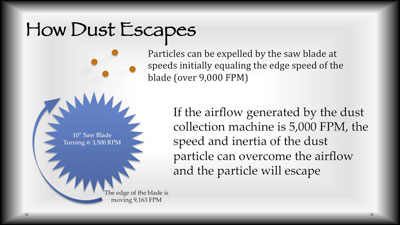
|
Figure 1 - Just one of the examples I give in my class why "point of capture"
is the often overlooked, but most important, aspect of dust collection
|
A 4-inch diameter pipe has a cross-sectional dimension of 0.08726 square feet. To achieve the "holy grail" of 400 CFM of airflow, the dust collector will need to generate an airstream moving at 5,000 feet per minute (5,000 FPM will actually produce a theoretical CFM of 436). A 10-inch table saw blade spinning at 3,500 RPM will throw dust particles out at a speed of 9,163 FPM. It is simply not possible for a 5,000 FPM airstream to overcome inertia, slow down, and capture a particle of dust moving at over 9,000 FPM.
Of course, some particles will be caught. Larger, heavier particles will not move as fast and air resistance and gravity will slow those particles more quickly. The airflow produced by the "dust collector" can grab and gobble them up. A guard over the top of the spinning blade helps. Dust hits the blade guard and bounces, slows, and the airflow can capture more… but still not all… some will escape and float about, unimpeded, in your shop.
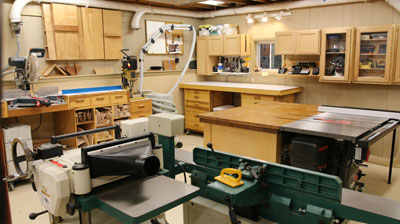
|
Figure 2 - Looks clean, doesn't it? Fact is, there is a fine
layer of dust accumulated on most surfaces despite excellent
primary "dust collection" and secondary air filtration
|
I have a large cyclone dust collector. The filter efficiency is high, the airflow outstanding. I routinely measure 400 to 600 CFM at the machine/dust collector pipe interfaces, even the ones furthest from the cyclone. In addition, I have a ceiling mounted shop dust filtration system moving air at over 900 CFM and capturing a claimed 99% of particles down to 5 microns in size. Even with all of that, and as clean as my shop always appears, you can wipe a finger along any wall and come up with dust… a lot of dust, unfortunately.
In my dust collection webinar class I encourage woodworkers to set their expectations realistically and approach dust collection as a "holistic" endeavor, with a focus on "point-of-capture" strategies, PPE, and supplemental air cleaners. A dust collector, no matter how good, simply won't do it all.
Please, please, please, don't mistake my heretical opinion of dust collection as an excuse to "give up" or to think that "any old dust collector" will do, or worse, do without. A good dust collector will collect larger chips and sawdust and will make woodworking machines run better, make the work environment nicer, will result in better outcomes, and will go a long ways toward cleaning up the air. A good dust collection system is absolutely essential, but understand, what we euphemistically call "dust collectors" are really just "chip collectors." A lot of ultra fine dust will escape and float freely about your shop. A secondary shop air filter will get a lot of that free-floating dust, but it will not get it all, either. To really clean the air in your shop, you need a tertiary air cleaner… one expressly made to "clean" the air, not just filter it.
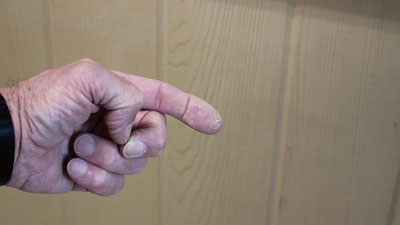
|
Figure 3 - These sawdust-colored walls are great for
hiding dust... but it's there!
|
Over the years I have bought many HEPA air filters for my shop. Big noisy units and small noisy units. Round units, square ones, tall skinny ones, odd-shaped ones, and even a few high-tech futuristic-looking ones. They all captured dust, as was obvious when it came time to change or clean the filter. But none worked as well as I had hoped and all had shortcomings. Most were way too noisy, the units were what I consider to be "consumer grade" (translated, that means "cheaply made" – they certainly weren't cheap to buy!). And they all eventually broke down or became ineffective. It was disappointing and I began to feel that no one made a really decent air cleaner. The core problem was that I was looking at air filters, not air cleaners. Then I happened to visit a few cigar bars.
Cigar smoking always seemed so convivial, and well, cool. And it seemed to me that cigar smoking goes naturally with other good things… a glass of wine or a single malt scotch, good conversation, perhaps a game of cards… but for some reason, even though I love those other things, I don't love cigars.
It is not for a lack of trying. I've tried expensive cigars, really expensive cigars, and cheap cigars. Long ones, fat ones, thin ones, mild and strong, dark and light, domestic and foreign, some that were probably even illegal to own… I just can't seem to develop a taste for the things… but I tried. Along the way I visited a number of really swank, high-end cigar bars. It was at these better cigar bars that I started to notice a commonality besides the ambience and fellowship. A certain type of air purifier seemed to be the de facto "standard." I learned, by asking, that the air purifiers that upscale cigar bars are using is the Rabbit Air, declared "best" by Cigar Aficionado Magazine.
The cigar story is simply a way to provide backdrop for a recent "wood shop experience." After a couple of days away, I opened the door of my shop for a much-anticipated day of woodworking, only to be confronted by a noticeable "aroma." Well, let's be honest, it was really a "stink." My couple of days away made me realize I had gone "nose blind" to the smell of my shop. By the way, isn't "nose blind" one of the greatest commercial tag lines ever?
I tried to sort out the aroma. There was a smell of wood, of course… several varieties, in fact. But there was more. Some lingering fumes of finishes still curing… a little mold smell, an entirely different story… a scented trash bag that smells worse than the trash… residual smell from the last batch of coffee beans I roasted… the space-age oil I spray on top of my cast iron tools to prevent rust… probably more… all intermingled into one really unpleasant odor. While I was contemplating the stink I remembered all those Rabbit Air Purifiers I had seen at various cigar bars. My thought process was straightforward… if one of those things could clear the air of cigar smoke, surely it could clear the air in my shop.
My initial research turned up a rather daunting price range of $459 to $559 (depending on air handling capacity) and immediately visions of other tools and woodworking supplies began to dance in my head, as is normally the case. I equate almost any expenditure to what an equivalent amount of money would buy in new tools. Still, I had to give fair consideration to my health and overall comfort as well.
You see, I have allergies. Pollen, dust, and mold are the worst offenders, but other things affect me, too. My allergies were awful as a child, I seemed to "grow out of it" in my middle years, and now, it's like I'm going through a second childhood. Mowing the grass makes me sneeze and sniffle. Floating dust in the workshop does, too. Strong perfumes send me straight to the tissues, the makeup department at the store will put me into shock (okay, not really, but when my wife shops there, I just keep thinking of all the tools that money would buy). I guess you can rationalize anything if you want it bad enough, but the price of the Rabbit Air Purifier was beginning to look more like an investment in my personal health than a luxury for my workshop.
Then one day I was installing yet another fixture to the wall to hold various hand tools (my chisel collection is swelling a bit), and I decided to use a damp cloth to wipe down the wall before mounting the new chisel rack. What I wiped off the wall was truly surprising. My top-notch dust collection system and powerful ceiling-mounted dust filter were still allowing the walls to accumulate a covering of superfine dust. It was disturbing and eye-opening. With no further procrastination I pulled out my well-worn credit card and ordered the Rabbit MinusA2 Ultra Quiet Air Purifier, Model SPA-780A, their biggest unit. The company claims this model to be adequate for spaces up to 815 square feet (about 30% larger than my shop's first floor).
The online ordering process was simple, professional, and straightforward. Within seconds I had an order confirmation, and within an hour a shipping notification and tracking number. The unit arrived a few days later, and the box seemed unscathed from its cross-country journey. The first thing I noticed was what I refer to as "designed and engineered" packaging. It may seem a trifle, but when a company thinks through the packaging and designs it carefully, it indicates the product inside is just as likely to be thoughtfully designed and built. It is.
An option with the Rabbit Air is to wall mount the unit, and that was my intent. The optional wall-mounting bracket was inside the package, and the instructions were simple. Remove the base of the Rabbit Air unit, attach the metal wall plate to the wall, hang the unit. Most consumer appliances these days, regardless of price, seem to be made with every cost-cutting option available. It is quite common to see cheap self-tapping screws joining plastic to plastic… not the Rabbit Air. Much to my surprise, and pleasure, the screws holding the base in place were sunk into brass fittings epoxied into the body of the unit. Classy.
After mounting the unit to the wall, the only step necessary before using the unit is to remove the protective plastic wrap from the filters. Removing the cover to reveal the filters was another experience in design and construction excellence. The cover utilizes shiny metal tabs and magnets to hold it in place. I can't begin to tell you how many times a piece of household equipment has been rendered useless by some cheap-o plastic tab snapping off instead of "snapping in." Well done.
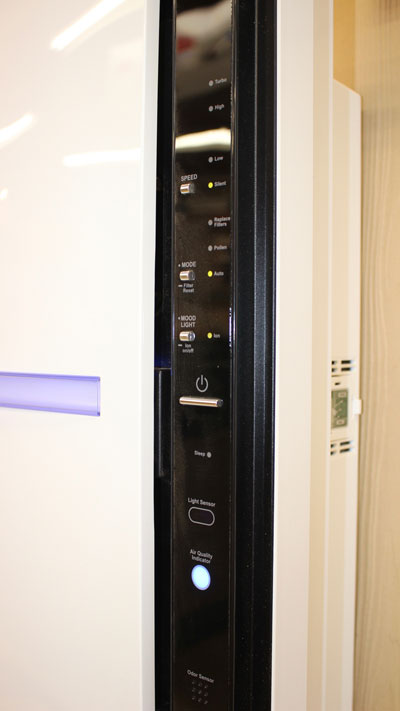
|
Figure 4 - The comprehensive control
panel is well arranged and easy to
understand
|
The instructions for filter preparation are clear and immensely straightforward. Every part is labeled and each filter has a tag to indicate which side is up. Putting it all together is child's play.
There are five (yep, count ‘em – five) stages of filtration. The first is a "pre-filter" and is the only filter that needs any maintenance. An occasional cleaning with a shop vacuum or hand washing will keep the pre-filter clean. Next is a "medium" filter that catches particles larger than 1 micron that the first filter might miss. Following that is a true HEPA filter that traps 99.97% of particles down to 0.3 microns in size. Following the HEPA filter is the "custom" stage filter. You choose when ordering from "Toxin Absorber," "Pet Allergy," "Germ Defense," and "Odor Remover." Following the custom filter is an activated carbon filter. This, by the way, is unlike any activated carbon filter I have ever seen. It contains a significant amount of carbon, arranged in such an ingenious way that air simply must flow through it.
When I placed my order it was difficult to decide which custom filter I wanted to try. The "Toxin Absorber" traps VOCs, and might be a perfect choice since I do a lot of finishing in my shop and can't keep the windows open all the time. The "Germ Defense" filter traps bacteria, mold, and virus-carrying particles, and since mold is one of my worst allergens, might also be a good choice. I don't have a pet in my shop, but the "Pet Allergy" filter traps animal dander and pet odors and might have been a good choice if my cats hung out with me in the shop. I eventually opted for the "Odor Remover" filter, given my "nose blind" state. I figured the best test of the efficacy of the Rabbit Air unit would be to invite my wife for a shop visit… she has a keen sense of smell and would not hesitate to tell me if the shop "stinks." Honesty between spouses is wonderful.
By the way, as if five stages of filtration are not enough, the Rabbit Air can also generate negative ions that latch onto airborne particles. Tiny particles are thus made heavier and easier to collect in the filtration system or else to fall to the floor harmlessly. The negative ion generator can be turned on or off.
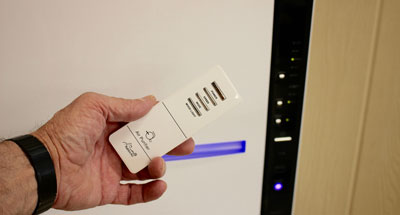
|
|
Figure 5 - You might think this superfluous, but you will use it!
|
There have been some health questions surrounding the production of ozone by some air purifiers. The Rabbit Air has been tested and with the negative ion generator turned on and the fan running at low speed, the air purifier produces ozone at a rate some 25 times lower than the California Air Resources Board requirements. I would assume California has the strictest indoor air quality regulations (they certainly do with everything else environmental), so for me, there is nothing to worry about.
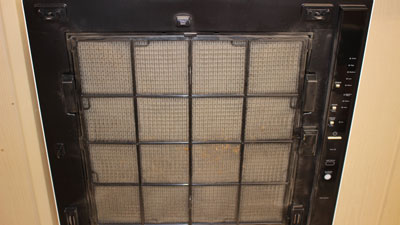
|
Figure 6 - Click on this photo to enlarge it, and you will see the airborne dust
captured by the pre-filter in just one week
|
Operating the Rabbit Air Minus A2 is easy. Pressing the Power Button the first time turns the unit on in Auto Mode. In this mode the Mood Light (which is also a status indicator) will be solid blue. The Air Quality Indicator light will change in color, indicating the amount of impurities detected in the air, and the speed of the machine adjusts automatically. If the air is really dirty, the fan will run at a high speed. As the air is cleaned, the speed will decrease. In Auto Mode, a special Sleep Mode will be activated if darkness is detected for three minutes or longer. In Sleep Mode the fan runs at its lowest setting (called Silent Mode) and the Mood Light and Air Quality indicator lights turn off. The unit will retain these settings until light is again detected in the room.
In addition to Auto Mode, there is a setting called Pollen Mode. In this mode the Mood Light gently shifts in color from blue to purple to light purple to pink and back again. Like in Auto Mode the fan will adjust speed to match the detected air quality, but when the lights go out, the fan speed will continue to adjust for air quality, forsaking silence for cleanliness. This is how I have my system set up.
The fan speed of the unit can be manually selected and most of the controls are also available via the included remote. The sensitivity of the air quality sensors can be adjusted and a light will indicate when it is time to replace the filters. The pre-filter can be vacuumed or washed. The company recommends once per month, but I have been doing it every-other week. It takes all of 2 minutes to do, and there has always been a layer of dust to remove. The other filters should be replaced once per year. Filter replacement costs are reasonable, given the quality and engineering.
The unit is, as the speed setting suggests, virtually silent in "Silent Mode." Frankly, it's not all that loud in any mode. When making videos in the Down To Earth Woodworking shop I don't even bother to turn the unit down or to "Silent Mode" when recording.
If you have allergies or any other respiratory issues, if you want to make sure you are breathing the cleanest air possible, or if you agree and understand that even the best shop dust collection system is only doing part of the job, you should consider an air purifier to complete the holistic approach to clean air. The Rabbit Air Minus A2 is a quality-built unit, thoughtfully designed and engineered to last, and is simply the best air filtration unit I have ever used. So much so, in fact, I am saving up to buy one for inside the house. And that funny smell in my shop? All gone now… my wife confirmed it… thank you!
(Page 1 of 4)
1
2
3
4
Next Page
Return to
Wood News
front page
